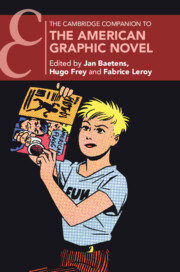Book contents
- The Cambridge Companion to the American Graphic Novel
- The Cambridge Companion to the American Graphic Novel
- Copyright page
- Contents
- Figures
- Contributors
- Editors’ Acknowledgments
- Introduction
- Part I History and Genre
- 1 The “First” Graphic Novel in America
- 2 The Mad-Men Generation
- 3 From Justin Green and Art Spiegelman to Alison Bechdel
- 4 Graphic Journalism
- 5 “Great” American Graphic Novels
- 6 Crime
- 7 Superheroes in Graphic Novels
- 8 Science Fiction and Fantasy
- 9 “Scared Witless”
- Part II Graphic Novels and the Quest for an American Diversity
- Index
- Cambridge Companions To …
- References
3 - From Justin Green and Art Spiegelman to Alison Bechdel
Writing the Self in the Graphic Novel
from Part I - History and Genre
Published online by Cambridge University Press: 10 January 2024
- The Cambridge Companion to the American Graphic Novel
- The Cambridge Companion to the American Graphic Novel
- Copyright page
- Contents
- Figures
- Contributors
- Editors’ Acknowledgments
- Introduction
- Part I History and Genre
- 1 The “First” Graphic Novel in America
- 2 The Mad-Men Generation
- 3 From Justin Green and Art Spiegelman to Alison Bechdel
- 4 Graphic Journalism
- 5 “Great” American Graphic Novels
- 6 Crime
- 7 Superheroes in Graphic Novels
- 8 Science Fiction and Fantasy
- 9 “Scared Witless”
- Part II Graphic Novels and the Quest for an American Diversity
- Index
- Cambridge Companions To …
- References
Summary
This chapter studies the developments of autobiography as a literary genre in the graphic novel production since the 1960s. It analyzes the formal connections between author, narrator, and character, paying attention to the pragmatic aspects of the contract between author and reader, whose commitment to authenticity distinguishes autobiography from autofiction or semi-autobiography. The chapter starts with a historical overview of the genre, absent in comics for a long time, then rapidly coming to prominence in the graphic novel. It emphasizes the role of underground comix and engages in a close reading of two works: Justin Green’s Binky Brown Meets the Holy Virgin (1972) and Craig Thompson’s Blankets (2001). Although both share a similar (critical) concern with the role of religion, their stylistic and narrative features and context are widely divergent. Green’s work is a clear example of countercultural transgression, whereas Blankets exemplifies the growing overlap between the graphic novel and young adult literature.
Keywords
- Type
- Chapter
- Information
- The Cambridge Companion to the American Graphic Novel , pp. 57 - 71Publisher: Cambridge University PressPrint publication year: 2023



